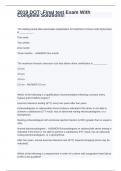-
1. Exam (elaborations) - Dot exam questions & answers 100% correct
-
2. Exam (elaborations) - Dot certification exam questions and answers 100% accurate
-
3. Exam (elaborations) - Dot exam study guide with complete solutions!
-
4. Exam (elaborations) - Dot exam 2023/2024 questions & answers(graded a+ )
-
5. Exam (elaborations) - Dot exam questions with correct answers
-
6. Exam (elaborations) - Dot exam questions & answers(rated a+)
-
7. Exam (elaborations) - Nrcme (dot) exam 2022/2023 questions & answers(scored a+)
-
8. Exam (elaborations) - Dot medical examiner review with complete verified solutions!
-
9. Exam (elaborations) - Dot physical exam questions & answers 100% solved
-
10. Exam (elaborations) - Dot certification medical examiner test exam questions & answers 100% verified
-
11. Exam (elaborations) - Dot exam questions & answers 100% pass
-
12. Exam (elaborations) - Dot exam questions & answers graded 100%
-
13. Exam (elaborations) - Dot cert exam questions & answers rated a
-
14. Exam (elaborations) - Dot exam questions & answers 100% accurate
-
15. Exam (elaborations) - Fmcsa dot physical medical examiner test exam questions & answers 100% correct
-
16. Exam (elaborations) - Dot exam questions and answers 100% solved
-
17. Exam (elaborations) - Dot medical examiner testing question and answers (rated a+)
-
18. Exam (elaborations) - Dot exam questions & answers(graded a)
-
19. Exam (elaborations) - Nrcme dot examiner test practice questions with correct answers
-
20. Exam (elaborations) - Dot exam test bank exam questions & answers(scored a+)
-
21. Exam (elaborations) - Dot exam 2023/2024 exam questions and answers graded a+
-
22. Exam (elaborations) - Dot study 2024 exam questions and answers 100% solved
-
23. Exam (elaborations) - Final test questions nrcme dot exam with correct answers
-
24. Exam (elaborations) - Dot fmcsa medical examiner exam questions and answers
-
25. Exam (elaborations) - Dot exam medications questions and answers graded 100%
-
26. Exam (elaborations) - Dot exam emedhome questions & answers(100% verified)
-
27. Exam (elaborations) - Dot medical examination questions & answers 100% pass
-
28. Exam (elaborations) - Dot - musculoskeletal exam questions & answers
-
29. Exam (elaborations) - Dot exam- psych questions and answers 100% rated correct
-
30. Exam (elaborations) - Dot-waiting periods exam questions 100% accurate answers
-
31. Exam (elaborations) - 2019 dot: comprehensive review for nrcme exam questions & answers
-
32. Exam (elaborations) - Dot exam respiratory questions & answers 100% correct
-
33. Exam (elaborations) - Dot exam - nrcme training institute material questions and answers 100% correct
-
34. Exam (elaborations) - Dot alcohol/drug exam questions and answers rated a+
-
35. Exam (elaborations) - Dot- hearing exam questions and answers 100% verified
-
36. Exam (elaborations) - Dot exam- diabetes questions & answers 100% correct
-
37. Exam (elaborations) - Dot exam- respiratory questions & answers
-
38. Exam (elaborations) - Dot exam: pre-test, dm and audiology exam questions & answers 100% pass
-
39. Exam (elaborations) - Dot training course missed questions exam with accurate answers
-
40. Exam (elaborations) - Dot final exam questions and answers 100% correct
-
41. Exam (elaborations) - Dot: medical examination certification questions & answers latest update
-
42. Exam (elaborations) - Dot national registry exam questions & answers
-
43. Exam (elaborations) - Dot vision exam questions & answers 100% accurate
-
44. Exam (elaborations) - 2019 dot vision and hearing exam questions & answers 100% correct
-
45. Exam (elaborations) - 2019 dot: drug abuse and alcoholism exam questions & answers(graded a+)
-
46. Exam (elaborations) - Sample questions dot exam questions & answers 100% correct
-
47. Exam (elaborations) - Dot certified medical examiner study cards - vision exam questions & answers 100% acc...
-
48. Exam (elaborations) - Dot from aanp review test exam questions & answers 100% verified
-
49. Exam (elaborations) - Dot online sample quiz exam questions & answers 100% correct
-
50. Exam (elaborations) - 2019 dot: final test exam with complete solutions!
-
51. Exam (elaborations) - Dot exam- drug & alcohol abuse questions & answers 100% correct
-
52. Exam (elaborations) - Dot exam nrcme study guide with complete solutions
-
53. Exam (elaborations) - Dot certification exam questions & answers 100% verified
-
Show more




